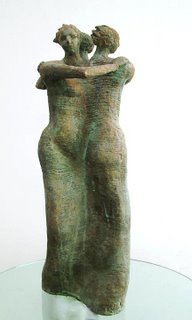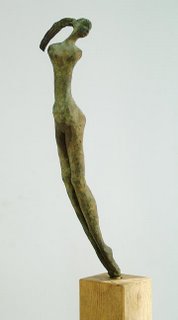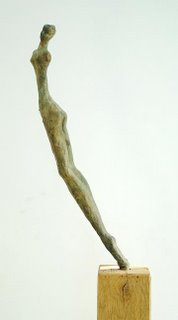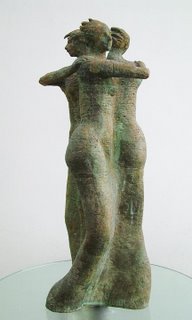From clay to bronze, and back again — works by Hanneke van den Bergh
Thursday, October 26th, 2006 Posted by Karl Zipser
Posted by Karl Zipser
Accidents Happen
Hanneke van den Bergh‘s husband dropped this ceramic sculpture and it shattered on the sidewalk. Her 50 cm high wood-fired piece was a central work for the exhibition to be installed that day . . .
A year later Hanneke was still wondering what to do with the broken sculpture. She had reassembled and glued it together, but did not contemplate selling it. In the meantime, she had been experimenting with bronze casting on a small scale. Using this knowledge of casting, Hanneke decided to try to give new life to the damaged clay sculpture.
The lost wax method
Transforming the clay form to bronze requires an intermediate step, creating a wax replica of the sculpture. Hanneke made this wax form by making a rubber cast of the ceramic sculpture, embedded in a plaster cast. Into the empty cast she poured melted wax to make a hollow wax impression of the clay form.
When the wax version of the sculpture was ready, it gave Hanneke the opportunity to make new creative input. She modified the wax form, adding more interesting hair to the figures in wax, for example. The sculpture now combined the properties of both clay and wax forms.
To cast the bronze, the wax is embedded in a plaster and gravel column. The hollow interior is also filled with the plaster and gravel; Conduits for the bronze to flow in, and the air to flow out, are made. Then the plaster-gravel-wax mass is heated in a kiln, causing the wax to flow out and sublimate, leaving an empty shell of air where the bronze is to come. This is why this is called the “lost wax” method — the wax model is destroyed in the process.
Bronze is heated to 1200 centigrade in a crucible. The molten bronze, with a consistency like cream, is poured into the mold. The pouring of the glowing, liquid metal is a spectacular sight. The sound is also surprising, the sound of a tall glass being filled with water from a pitcher.
 When cool, the bronze sculpture is freed from the plaster and gravel, cleaned of excess metal, and given a patina, in this case green. The result is a new version of the original sculpture with an entirely different aesthetic effect (click images to enlarge.)
When cool, the bronze sculpture is freed from the plaster and gravel, cleaned of excess metal, and given a patina, in this case green. The result is a new version of the original sculpture with an entirely different aesthetic effect (click images to enlarge.)
The bronze version of the above sculpture can be dropped on the sidewalk without breaking. In fact, its structure does not even test the limits of what bronze can do. With metal as her production medium, Hanneke began to sculpt in clay in a different way, making figures such as this woman (which would yield a fragile form as a fired ceramic piece.)  In bronze, this figure, based on a clay original, is stable even in this highly unbalanced mounting. Thus, the experience of working with bronze can influence the way Hanneke works in clay. Her work takes advantages of the best aspects of each medium — the plastic sensuality of the clay, the rigid firmness of the bronze.
In bronze, this figure, based on a clay original, is stable even in this highly unbalanced mounting. Thus, the experience of working with bronze can influence the way Hanneke works in clay. Her work takes advantages of the best aspects of each medium — the plastic sensuality of the clay, the rigid firmness of the bronze.
 For me a big lesson of my visit with Hanneke van den Bergh was that one should beware of talking with a bronze sculptor — one may find an irresistible urge to try this medium one’s self.
For me a big lesson of my visit with Hanneke van den Bergh was that one should beware of talking with a bronze sculptor — one may find an irresistible urge to try this medium one’s self.
Do you have questions for Hanneke van den Bergh? Ask them here on Art & Perception.
What do you think of the bronze version of the ceramic sculpture? Is it stronger, in the aesthetic sense? Or just different? Should Hanneke van den Bergh stick with clay, or combine the media as she does?
